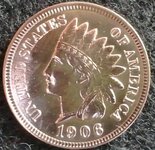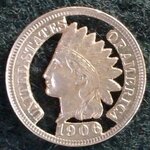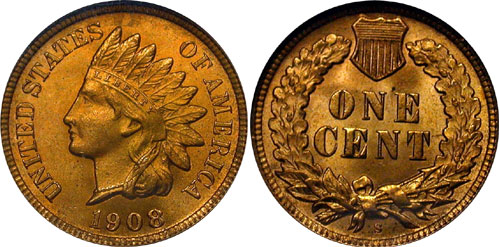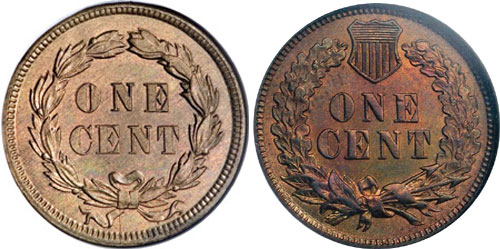Here is a little history behind the coin:
Indian Head Cent
The Indian Head Cent was the second series of small cents produced by the United States Mint. The series was introduced in 1859 after just two years of production for the previous
flying eagle design, which had experienced striking problems. The new design was adopted in an attempt to address these problems by better balancing the obverse and reverse relief elements to achieve better metal flow. Ultimately, it would take a composition change to fully address the striking issues. After this modification, the series would continue to be produced until 1909.
The obverse design features the head of Liberty, facing left and wearing an Indian headdress with the band inscribed "Liberty". The words "United States of America" surround, with the date positioned below. The original reverse design used only in 1859 featured a thin wreath of laurel, tied with a bow at the base. The denomination "One Cent" appears within. From 1860 until the conclusion of the series, the reverse design featured a thicker wreath of oak leaves, with three arrows tied at the base and a union shield above.
The design for the Indian Head Cent was created by James B. Longacre. A popular story within numismatic lore is that the model for the design was Longacre's young daughter named Sarah, who had adorned an Indian headdress either while at play or during a visit from a Native American chief. The legend states that Longacre was struck by the image and immediately made a sketch, which later became the basis for the coin design. The story has been disputed by some and there are similarities of the profile to some of the designer's earlier work.
Indian Head Cents were struck in usually large quantities for the duration of the series from 1859 to 1909. The notable exceptions are the key date 1877 and the issues for the final two years of the series struck at the San Francisco Mint.
Design and Composition Changes
The series underwent both design and composition changes during its five decade span. After just one year of production, the thin laurel wreath on the reverse was replaced by a thicker wreath of oak leaves surmounted by a shield. Some have cited an effort to improve the striking quality of the coins as the motivation. Others have cited the inclusion of the union shield at the top as propaganda to promote nationalism in order to prevent civil war.
Other design changes which occurred during the series were less dramatic. The designer's initial "L" was added to the lower ribbon on the obverse in 1864. For this year, coins can be found either "with L" or with "no L". In 1886, the placement of the word "America" on was shifted towards the top of the coin.
Initially, the Indian Head Cents were struck with a composition of 88% copper and 12% nickel, with a weight of 4.67 grams. The composition was difficult to work, resulting in the striking issues which had been experienced for small cents since their introduction. The price of nickel was also rising, pushing up the price of production. Additionally, the copper-nickel pieces were hoarded during the Civil War years. The solution was found by changing the composition to bronze, which consisted of 95% copper, 3% tin, and 2% zinc. The planchets used were also noticeably thinner and with a lower weight of 3.11 grams.
Highlights and Rarities
1877 – This issue is a well known key date and always in demand as such. The reported mintage was 852,500 pieces, although the availability of the issue suggests that the actual number might be less. Expert Rick Snow has suggested that only 200,000 coins were struck. Whatever the actual number, this coin is rare in all grades and hard to find with good eye appeal.
1909-S – This coin was issued in the final coin for the series and represented only the second cent produced at the San Francisco Mint. The 1909-S Indian Head Cent carries the lowest reported mintage of the series at 309,000 pieces. A great deal of this original mintage was soon removed from circulation and hoarded, making the coins not as rare as the mintage suggests. However, the coin does remain an important and historic issue within this popular series.
Specifications
Designer James B. Longacre Dates 1859-1909 Mints Philadelphia, San Francisco Composition 88% Copper, 12% Nickel (1859-1864)
95% Copper, 5% Tin and Zinc (1864-1909) Weight 4.67 grams (1859-1864)
3.11 grams (1864-1909) Diameter 19 mm






